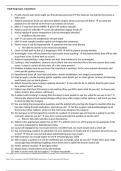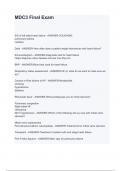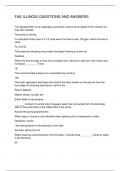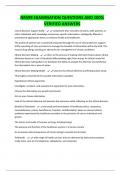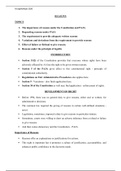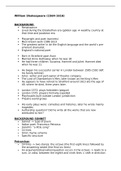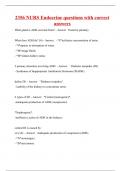Topics in corporate finance lecture notes
Week 1
Net present value and other investment criteria (assumed pre-knowledge)
Annuity vs perpetuity
Valuation of bonds
Perpetuity/growing perpetuity/annuity formulas
NPV model
Uses cash flows
o Better to use than earnings
Uses all cash flows
o Other approaches ignore CFs beyond a certain date
Discounts cash flows
o Fully incorporates the time value of money
Weakness of NPV:
o One needs to determine the discount rate
Payback period
Time taken for initial investment to be repaid out of project net cash inflows
If PP is shorter than project duration, project should be accepted
Discounted payback
The length of time required for an investment’s discounted cash flows to equal its initial
cost
Accept if: discounted payback is less than benchmark
Internal rate of return (IRR)
The discount rate, which, when applied to the future project cash flows, produces a zero NPV
If IRR>discount rate, accept the project
Problems with IRR:
o Ignores the scale of the investment
o Has difficulty with unconventional cash flows
Non-conventional cash flows
Multiple rates of return
o The possibility that more than one discount rate will make the NPV of an investment
zero
Rule of thumb
o The max number of IRRs there can be is equal to the number of times that the cash
flows change sign from positive to negative and/or negative to positive
The profitability index
The present value of an investment’s future cash flows divided by its initial cost. Also called
the benefit‐cost ratio
,Making capital investment decisions
What is relevant for project evaluation?
Always use cash flows
Use only incremental cash flows
Operating cash flows
Three moments:
CFs at the beginning of a project
o Investment cost of the project Io
CFs during project
o Operating cash flows (OCF)
CFs at the end of a project
o Salvage value
Calculation of OCFs
Revenues R
-Operating costs (C)
-Depreciation (Depr)
Operating profit before taxes X
‐Taxes on operating profit (T.X)
Net operating profit after taxes X(1-T)
+ Depreciation Depr
-Increase in NWC (NWC)
-Necessary capital expenditures (Capex)
Operating Cash Flows OCF
Why add depreciation?
Depreciation is a non-cash cost?
Deducted before taxed and re-added afterwards
Investments in working capital
NWC = ST assets – ST liabilities
Short‐term assets:
o Cash, accounts receivable, inventories
Short‐term liabilities:
o Accounts payable, accruals
Investments in working capital result in cash outflows
Interest costs?
NOT included in cash flows, already reflected in discount rate
Relevant cash flow
A relevant cash flow for a project is a change in the firm’s overall future cash flow that comes
about as a direct consequence of the decision to take that project
, Cost definitions
Opportunity costs: Opportunity costs are lost revenues that you forego as a result of making
the proposed investment
o Rule :Incorporate Opportunity Costs into your analysis
Sunk costs: sunk cost is a cash flow that has already occurred
o Rule: Ignore all sunk costs
Side effects: A side effect is classified as either erosion or synergy
o Erosion is when a new product reduces the cash flows of existing products
o Synergy occurs when a new project increases the cash flows of existing projects
o Rule: Include side affects
Salvage value:
o CF at the end, include any tax effects
Inflation – general rule
Nominal CFs must be discounted at a nominal rate
Real CFs must be discounted at a real rate
(1+Knom) = (1+Kreal)(1+h)
->Practice examples on all these topics in slides!
--------------------------------------------------------------------------------------------------------------------------------------
Week 2
NPV Model
Principles of capital budgeting
1. Only look at cash flows
2. Only incremental cash flows matter
a. Expansion project
b. Replacement project
3. Ignore sunk costs
4. Take opportunity cost into account
5. Evaluate possible side effects (erosion)
6. Ignore interest costs
7. Treat inflation consistently
8. Do not forget working capital requirements
9. Watch out for tax implications
10. Pick the right risk‐adjusted discount factor
How to determine the discount rate?
1. Listed firms
a. All‐equity financed
b. Levered
2. Unlisted firms
3. Project
Week 1
Net present value and other investment criteria (assumed pre-knowledge)
Annuity vs perpetuity
Valuation of bonds
Perpetuity/growing perpetuity/annuity formulas
NPV model
Uses cash flows
o Better to use than earnings
Uses all cash flows
o Other approaches ignore CFs beyond a certain date
Discounts cash flows
o Fully incorporates the time value of money
Weakness of NPV:
o One needs to determine the discount rate
Payback period
Time taken for initial investment to be repaid out of project net cash inflows
If PP is shorter than project duration, project should be accepted
Discounted payback
The length of time required for an investment’s discounted cash flows to equal its initial
cost
Accept if: discounted payback is less than benchmark
Internal rate of return (IRR)
The discount rate, which, when applied to the future project cash flows, produces a zero NPV
If IRR>discount rate, accept the project
Problems with IRR:
o Ignores the scale of the investment
o Has difficulty with unconventional cash flows
Non-conventional cash flows
Multiple rates of return
o The possibility that more than one discount rate will make the NPV of an investment
zero
Rule of thumb
o The max number of IRRs there can be is equal to the number of times that the cash
flows change sign from positive to negative and/or negative to positive
The profitability index
The present value of an investment’s future cash flows divided by its initial cost. Also called
the benefit‐cost ratio
,Making capital investment decisions
What is relevant for project evaluation?
Always use cash flows
Use only incremental cash flows
Operating cash flows
Three moments:
CFs at the beginning of a project
o Investment cost of the project Io
CFs during project
o Operating cash flows (OCF)
CFs at the end of a project
o Salvage value
Calculation of OCFs
Revenues R
-Operating costs (C)
-Depreciation (Depr)
Operating profit before taxes X
‐Taxes on operating profit (T.X)
Net operating profit after taxes X(1-T)
+ Depreciation Depr
-Increase in NWC (NWC)
-Necessary capital expenditures (Capex)
Operating Cash Flows OCF
Why add depreciation?
Depreciation is a non-cash cost?
Deducted before taxed and re-added afterwards
Investments in working capital
NWC = ST assets – ST liabilities
Short‐term assets:
o Cash, accounts receivable, inventories
Short‐term liabilities:
o Accounts payable, accruals
Investments in working capital result in cash outflows
Interest costs?
NOT included in cash flows, already reflected in discount rate
Relevant cash flow
A relevant cash flow for a project is a change in the firm’s overall future cash flow that comes
about as a direct consequence of the decision to take that project
, Cost definitions
Opportunity costs: Opportunity costs are lost revenues that you forego as a result of making
the proposed investment
o Rule :Incorporate Opportunity Costs into your analysis
Sunk costs: sunk cost is a cash flow that has already occurred
o Rule: Ignore all sunk costs
Side effects: A side effect is classified as either erosion or synergy
o Erosion is when a new product reduces the cash flows of existing products
o Synergy occurs when a new project increases the cash flows of existing projects
o Rule: Include side affects
Salvage value:
o CF at the end, include any tax effects
Inflation – general rule
Nominal CFs must be discounted at a nominal rate
Real CFs must be discounted at a real rate
(1+Knom) = (1+Kreal)(1+h)
->Practice examples on all these topics in slides!
--------------------------------------------------------------------------------------------------------------------------------------
Week 2
NPV Model
Principles of capital budgeting
1. Only look at cash flows
2. Only incremental cash flows matter
a. Expansion project
b. Replacement project
3. Ignore sunk costs
4. Take opportunity cost into account
5. Evaluate possible side effects (erosion)
6. Ignore interest costs
7. Treat inflation consistently
8. Do not forget working capital requirements
9. Watch out for tax implications
10. Pick the right risk‐adjusted discount factor
How to determine the discount rate?
1. Listed firms
a. All‐equity financed
b. Levered
2. Unlisted firms
3. Project

